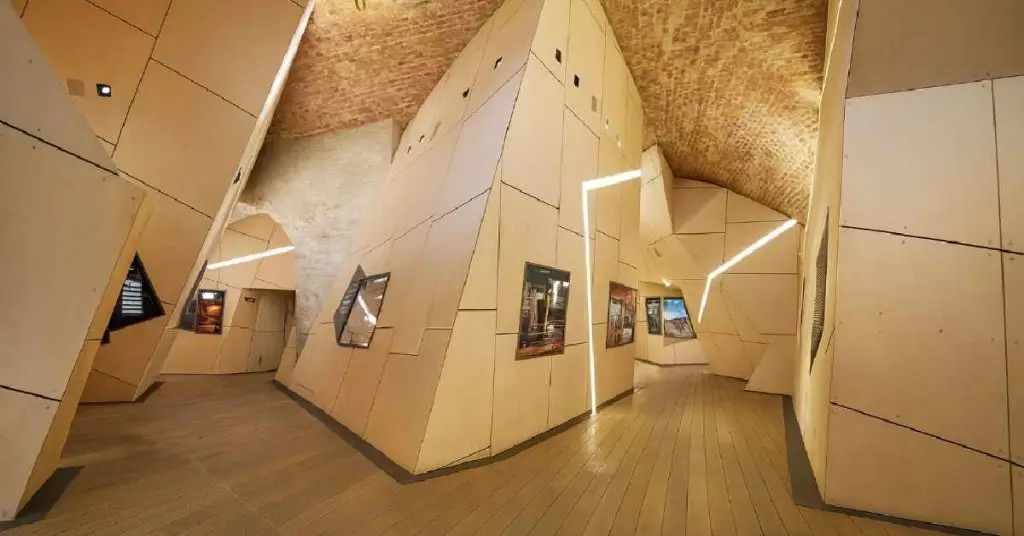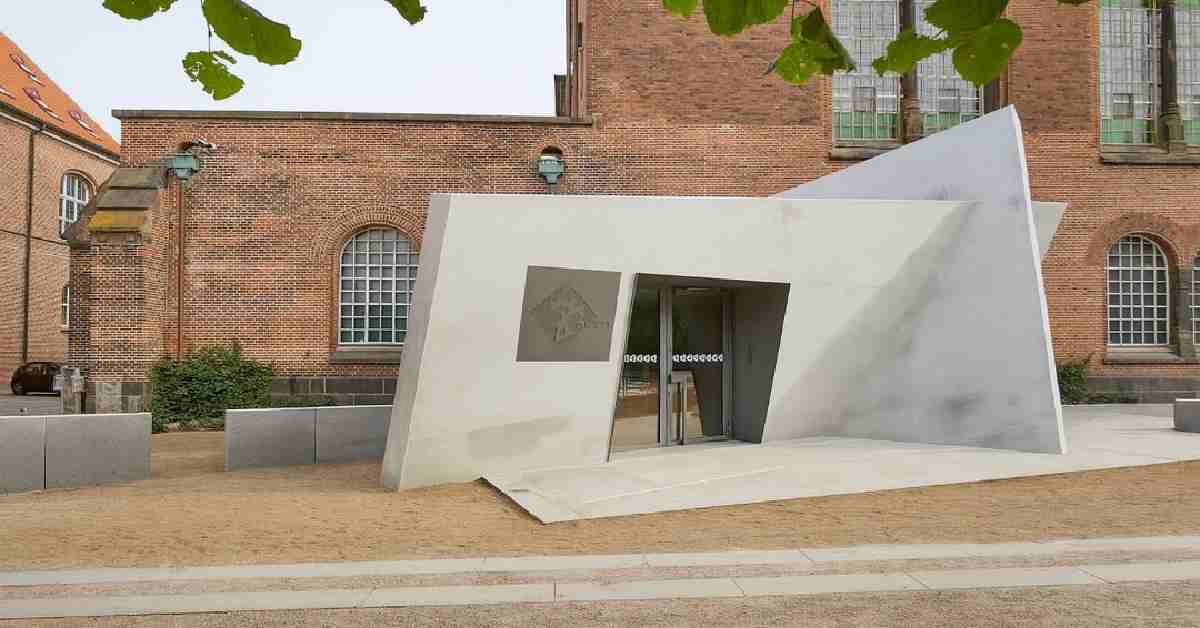The architectural design of The Danish Jewish Museum, crafted by the world-renowned architect Daniel Libeskind, is an artistic masterpiece in itself. Opened in 2004, the museum’s structure is a striking example of Libeskind’s ability to convey deep ideological and emotional themes through architecture. I admired the building’s angular corridors and dynamic use of space. In fact, the design keeps your excitement up as your tour progresses. The experience reminded me of my wondrous tour of the Danish Architecture Center.
Libeskind’s background in designing projects with profound historical implications, such as the Jewish Museum Berlin, lends a unique gravitas to The Danish Jewish Museum. The architectural design is both a tribute to the over 8,000 Danish Jews who were able to successfully escape to safety in Sweden during World War II and a memorial to the lives and stories preserved within its walls. The museum’s design itself forces visitors to physically engage with the space. Thus, moving through its sharp angles and tilted floors, creating a tangible and immersive experience.
The Danish Jewish Museum: Preserving a Rich Cultural Heritage and More
The Danish Jewish Museum is not just a repository of artifacts. It is an active participant in the preservation and promotion of Jewish culture in Denmark. Home to a collection of over 5,000 objects, the museum compassionately chronicles the Jewish presence in Denmark. This is from the 17th century to till date. These artifacts include religious texts, ceremonial objects like menorahs and Seder plates, family heirlooms, and personal stories.
What sets The Danish Jewish Museum apart is not just the breadth of its collection but the depth. Amongst the artifacts are documents and items that reveal the complexity of Jewish life during the German occupation in World War II. This includes not just objects of historical significance but also personal stories and multimedia installations. Such items illustrate the individual and collective journeys of Danish Jews.
The museum also serves as an educational resource, partnering with various institutions to facilitate research. And it promotes the understanding of Jewish culture and history. Through its programs and exhibitions, The Danish Jewish Museum seeks to foster dialogue on important cultural and historical issues.
A Beacon of Tolerance and Heroism
The Danish Jewish Museum is proof of one of the most remarkable acts of collective heroism during World War II. In October 1943, as Nazi forces prepared to deport Danish Jews to concentration camps, an extraordinary rescue operation unfolded. Ordinary Danish citizens, from all walks of life, facilitated the transport of their Jewish friends and neighbors across the Øresund strait to the safety of neutral Sweden. An estimated 7,200 Jews, along with 700 of their non-Jewish relatives, were saved as a result of these efforts.
Visiting The Danish Jewish Museum: Practical Information and Tips

When to Visit
The Danish Jewish Museum is open year-round, providing a warm and inviting atmosphere regardless of the season. It is generally open to the public from Tuesday to Sunday, with operating hours typically from 1:00 PM to 4:00 PM. However, checking the museum’s official website or contacting them directly for any changes in hours or special holiday closures is always recommended.
For those seeking a quieter experience, visiting during weekdays or early in the day can offer a more intimate exploration of the exhibits. The summer months, while a beautiful time to experience Copenhagen’s lively atmosphere, tend to attract more tourists. Hence, making off-peak seasons an ideal alternative for those desiring a more contemplative visit.
How to Get There
The museum is strategically located in Copenhagen’s inner city, making it easy to reach via multiple means of transportation. For those using public transit, the nearest station is Christianshavn Metro Station, which is approximately a 10-minute walk away. Visitors can also take buses that service this area, or if preferred, a leisurely walk from central Copenhagen can lead you directly to the museum.
For those driving, parking options include nearby street parking or public parking facilities, though it is worth noting that parking can be limited during peak hours. Visitors are encouraged to use public transportation where possible to avoid the hassle and to reduce their environmental footprint.
Conclusion
The Danish Jewish Museum is more than a collection of artifacts. Its innovative architectural design by Daniel Libeskind enhances the emotional and intellectual journey of visitors. Thereby, offering a profound experience that intertwines the historical, cultural, and personal narratives of Denmark’s Jewish community. Through thoughtful exhibitions and engaging programming, the museum fulfills its mission to educate, inspire, and foster reflection.
FAQs about The Danish Jewish Museum
1. What are the museum’s opening hours?
The Danish Jewish Museum is generally open from Tuesday to Sunday, typically between 1:00 PM and 4:00 PM.
2. Can I book a guided tour?
Certainly! The museum offers guided tours in both Danish and English. Reservations are recommended to secure a spot, as tours can enhance your understanding and appreciation of the exhibits.
3. Are there any dining facilities at the museum?
While The Danish Jewish Museum does not have a cafe or restaurant on-site, there are numerous dining options available nearby in Copenhagen’s vibrant central district.
4. What is the best way to reach the museum using public transport?
The museum is conveniently located near Christianshavn Metro Station, a short walk away. Several bus lines also service this area, making public transportation a practical option.
5. Are there any special events or exhibitions I should be aware of during my visit?
The museum regularly hosts special exhibitions and events. It is recommended to check their official website or contact them before visiting to gain insights into current or upcoming programs.




